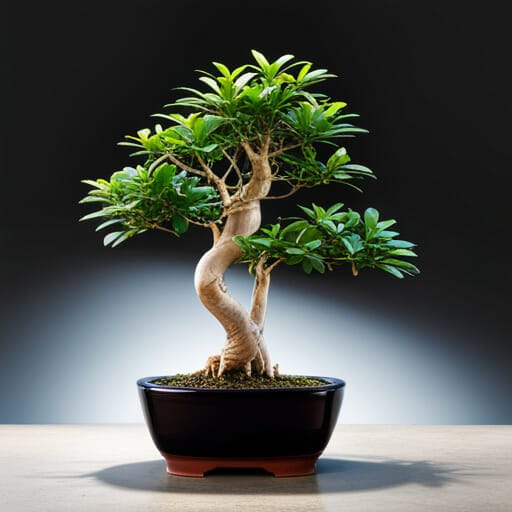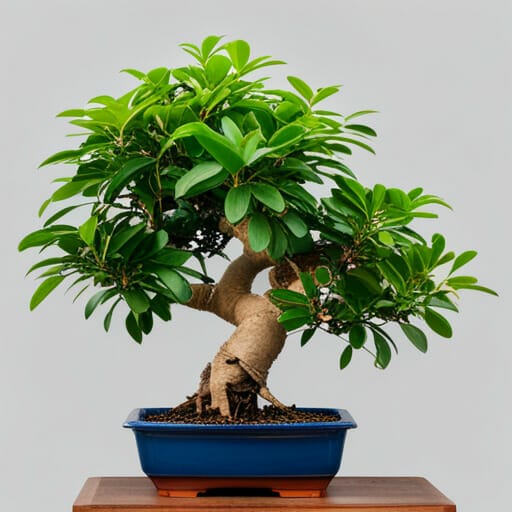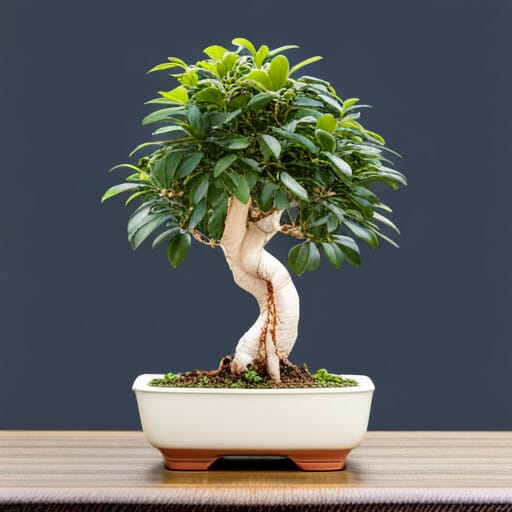Ficus Benjamina, commonly known as the weeping fig, is an exquisite choice for bonsai enthusiasts seeking a perfect blend of beauty and ease of care. This captivating tree, native to Asia, offers an enchanting presence that can evoke a sense of tranquility and harmony in any setting.
With its dark green, glossy foliage and small leaf size, Ficus Benjamina possesses the ideal characteristics for bonsai cultivation. Its fast growth rate and ability to respond well to pruning and wiring make it a delight for beginners and seasoned enthusiasts alike.
Not only does Ficus Benjamina provide a visually stunning canopy, but it also offers the convenience of thriving in less than ideal conditions. Its adaptability to indoor environments and tolerance for slightly lower light levels make it an excellent choice for those seeking a bonsai tree that can easily be incorporated into their living spaces. Additionally, its ability to develop into a dense, ramified bonsai tree, despite not back budding as prolifically as other ficus species, further adds to its appeal.
In this article, we will explore the characteristics and appearance of Ficus Benjamina, delve into its care and maintenance requirements, and discuss the benefits and drawbacks of choosing this remarkable tree for bonsai cultivation. Whether you are a beginner or an experienced bonsai enthusiast, Ficus Benjamina is a perfect choice that will bring joy and serenity to your life.
Contents
- 1 Quick Points
- 2 Characteristics and Appearance
- 3 Care and Maintenance
- 4 Benefits and Drawbacks
- 5 Frequently Asked Questions
- 5.1 Can Ficus Benjamina be trained to grow in different bonsai styles?
- 5.2 How often should Ficus Benjamina be watered?
- 5.3 Can Ficus Benjamina be grown from seeds or cuttings?
- 5.4 Does Ficus Benjamina require any special fertilizers or nutrients?
- 5.5 Are there any specific pests or diseases that commonly affect Ficus Benjamina bonsai trees?
Quick Points
- Ficus Benjamina is a popular choice for bonsai due to its fast growth, small leaf size, and ability to handle less than ideal conditions.
- It is easy to care for once settled in its environment and responds well to pruning and styling.
- Ficus Benjamina is best styled as a tropical evergreen with a large, luscious canopy and wiring is necessary for shaping.
– It is considered one of the best trees for bonsai, especially for beginners, and is recommended for those who like its appearance.
Characteristics and Appearance

Ficus benjamina exhibits desirable characteristics for bonsai, such as its recognizable foliage with oval shape and dark green, glossy color, as well as its small leaf size and ability to develop tight and compact internode length with good light levels. These features make it an ideal choice for bonsai enthusiasts who value the aesthetics of their trees.
The ficus benjamina is a fast-growing plant that can quickly develop into a dense, ramified bonsai tree. It can be grown indoors and tolerate slightly less than ideal light conditions, making it suitable for those who may not have access to outdoor gardening spaces.
Additionally, the ficus benjamina responds well to pruning, allowing for easy maintenance and shaping of the bonsai tree. Overall, its characteristics and appearance make ficus benjamina a perfect choice for bonsai enthusiasts.
Care and Maintenance

When it comes to the care and maintenance of Ficus Benjamina, it is essential to provide adequate lighting, regular pruning, and attention to root growth in order to ensure the long-term health and vitality of the plant.
To properly care for a Ficus Benjamina bonsai tree, consider the following:
- Lighting: Ficus Benjamina prefers bright, indirect light. Place the bonsai near a window where it can receive plenty of natural light, or use artificial grow lights to supplement.
- Pruning: Regular pruning is necessary to maintain the desired shape and size of the bonsai. Trim back new growth and remove any dead or unhealthy branches to encourage a dense, compact canopy.
- Root Growth: Keep an eye on the root growth of the bonsai. Repotting should be done every two to three years to prevent the roots from becoming root-bound. Trim back the roots during repotting to maintain a healthy root system.
By providing the appropriate care and attention, Ficus Benjamina can thrive as a beautiful bonsai tree.
Benefits and Drawbacks

One advantage of selecting Ficus Benjamina as a bonsai tree is its ability to tolerate less than ideal light conditions. This makes it a suitable choice for those who may not have access to optimal lighting conditions or for individuals who prefer to keep their bonsai indoors.
Ficus Benjamina is also known for its fast growth rate, allowing it to quickly develop into a dense and ramified bonsai tree. Additionally, this tree species has small leaf size, which is highly desirable for bonsai aesthetics.
However, it is important to note that Ficus Benjamina may not back bud as prolifically as other ficus species and caution must be exercised when wiring due to its rapid growth.
Despite these drawbacks, Ficus Benjamina remains a popular choice for bonsai enthusiasts, particularly beginners, due to its easy care and attractive appearance.
Frequently Asked Questions
Can Ficus Benjamina be trained to grow in different bonsai styles?
Yes, Ficus benjamina can be trained to grow in different bonsai styles. Its fast growth, small leaf size, and ability to back bud make it versatile for various techniques. Wiring and pruning are necessary due to its rapid growth.
How often should Ficus Benjamina be watered?
Ficus benjamina should be watered when the top inch of soil feels dry. It is important to avoid overwatering as it can lead to root rot. Proper watering is crucial for the health and growth of the bonsai tree.
Can Ficus Benjamina be grown from seeds or cuttings?
Ficus benjamina can be propagated from both seeds and cuttings. Seeds require a longer germination period and may produce variations in leaf size. Cuttings, on the other hand, have a higher success rate and can be rooted in water or soil.
Does Ficus Benjamina require any special fertilizers or nutrients?
Does Ficus Benjamina require any special fertilizers or nutrients? Ficus Benjamina benefits from regular fertilization with a balanced, water-soluble fertilizer during the growing season. It is important to provide essential nutrients to promote healthy growth and development of the bonsai tree.
Are there any specific pests or diseases that commonly affect Ficus Benjamina bonsai trees?
Common pests that can affect Ficus Benjamina bonsai trees include aphids, scale insects, and mealybugs. Diseases such as leaf spot and root rot can also occur. Regular inspection, proper watering, and appropriate pest control measures can help prevent and manage these issues.




